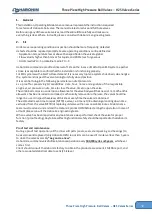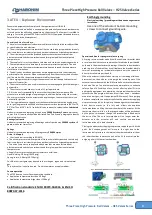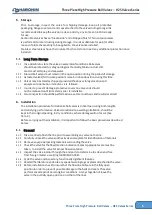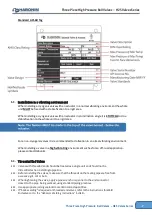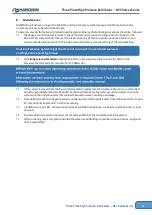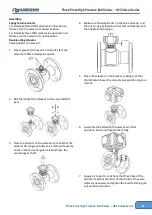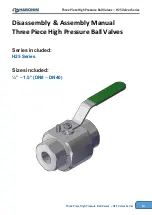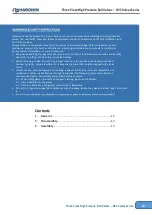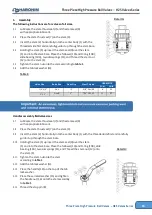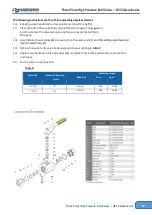
Three Piece High Pressure Ball Valves
–
H25 Valves Series
Three Piece High Pressure Ball Valves
–
H25 Valves Series
3
3. ATEX
–
Explosive Environment
Pneumatic equipment shall comply with the requirements of ISO 4414.
The Compact can be installed in any appropriate potentially explosive hazardous area
as listed on the identification nameplate on the actuator. The Compact is certified to
category 1 according to the ATEX Directive 2014/34/EU (Equipment intended for use in
Potentially Explosive Atmospheres).
Special condition for safe use.
1. Any electrical equipment (solenoid valves/limit switches) shall be suitably certified
as specified by the manufacturer.
2. The air compressor must incorporate a filter on the intake system and contain only
lubricants that are resistant to ignition or carbonization at anticipated temperatures.
3. The air delivery must not be provided by hoses that are manufactured from
elastomeric materials that can carbonize and form glow particles in anticipated
temperatures.
4. The supply of air must come from a safe area and contain no explosive gas or dust.
5. The temperature class is based on the maximum process temperature. The end
user must ensure that the process temperature does not exceed the temperature
classification limitations.
6. The ball valves have been assessed as simple equipment within the assessment
performed for the actuator. When used separately from the actuator, the ball valves
shall be used within the parameters permitted for the actuator.
7. No charging mechanism stronger than a manual rub shall be applied to external
non-metallic materials.
8. The actuator shall only be used in locations where a propagating brush discharge is
not possible.
9. The actuators must have a cycle rate of ≤1 cycle per minute.
10. It is the user’s responsibility to ensure that t
he system/internal parts of the
actuator are suitably purged of explosive gas. In addition, before using the actuator,
the users must enter into the actuator non-explosive gas, to ensure that there is no
potential for ignition.
11. During maintenance, the end user shall ensure that any lubrication used has an
auto-ignition greater than 50K above the maximum surface temperature (80°C for T6,
95°C for T5 and 130°C for T4) and shall also be resistant to carbonization.
Lubricated
seals
Habonim recommend replacing all seals every
500,000 cycles or 5 years
, whichever
comes first. All new seals should be lubricated. See “Lubricants” paragraph to identify
which lubricant to use.
Bearings/soft parts
Habonim recommend replacing all bearings and soft parts every
500,000 cycles or 5
years
, whichever comes first.
Springs
Habonim recommend replacing all springs every
500,000 cycles
.
Drive
–
Air Supply
• Use clean dry air according to ISO 4414.
• The air compressor must incorporate a filter on the intake system and contai
n only
lubricants that are resistant to ignition or carbonization at anticipated temperatures.
• The air delivery must not be provided by hoses that are manufactured from
elastomeric materials that can carbonize and form glow particles in anticipated
temperatures.
• Supply Pressure for the Compact actuators are as follows:
Double-acting: 2-8 barg (30-120 psig).
Spring-return: 3-8 barg (40-120 psig).
For IIB, other inert gases may be used such as nitrogen, argon and sweet natural
gas.
Thin hydraulic oil can also be used. Do not use water as a supply medium.
Severe operation
The ATEX does not cover Severe operating conditions:
• Application temperature less than
-50 deg C
• Application temperature higher than +120 deg C
Certification standards: EN ISO 80079-36:2016 & EN ISO
80079-37:2016
Earthing/grounding
Electrical earthing / grounding must be done during actuator
installation.
Use one of the actuator's bottom mounting
screws to connect grounding wire.
Special condition for spring return/air to spring
All spring return actuator models shall have a Namur breather block
or a solenoid valve that acts as a breather fitted to both port A and B
as shown in the manufacturer’s drawings. When the solenoid valve is
used in place of the breather, it shall replicate the breather block in
terms of preventing an internal atmosphere only the solenoid is
directly installed into port A and B.
When the actuator is operated on start up or from being off with no
pressurisation, the end user must purge the internal parts of the
actuator in accordance with the IOM manual to ensure there has not
been a build-up of an internal explosive atmosphere; to enhance
safety a Specific Condition of use to that effect applies (Prior to
putting the equipment into operation, the internal chambers of the
actuator shell be purged with clean, dry air from a non
–
hazardous
area or an inert gas; refer to equipment IOM manual). Once purging
has been completed, the end user shall start the actuator by supplying
air pressure to port A. At this point, a V-shaped gasket at the breather
block device moves to the left and allows non-explosive
instrumentation air filling the inner chamber of the actuator. At the
same time the air, which is in the spring chamber, will be pushed out
by the piston’s movemen
t through the actuator's port B and out to
the exit orifice. The outer atmosphere will no longer enter the
actuator and the actuator will only contain non-explosive
instrumentation air in both chambers.
Closing the actuator by stopping the pressure supply to port A. At this
point, the V-shaped gasket will move to the right due to the
instruments air pressure in the internal chamber and redirect it from
the inner chamber towards the exit orifice. At the same time the
outgoing air will fill the spring chambers.



